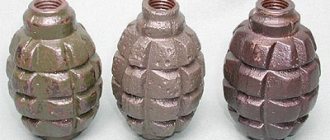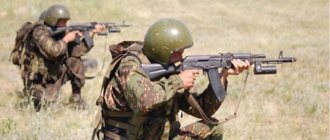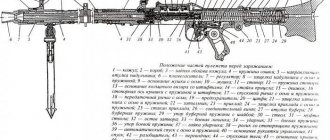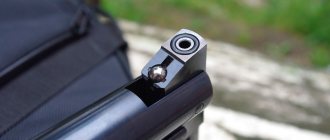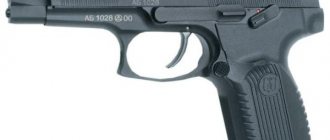1.1.Purpose, combat properties and general design of the F-1 hand fragmentation grenade
The F-1 hand fragmentation grenade is a remote-action grenade designed to destroy manpower primarily in defensive combat.
The F-1 hand-held defensive grenade (“limon”) was developed on the basis of the French F-1 fragmentation grenade of the 1915 model, hence the designation F-1. This grenade should not be confused with the modern French F1 model with a plastic body and semi-finished fragments and the English Lemon grenade (with a grating fuse), supplied to Russia during the First World War. The F-1 grenade was adopted by the Red Army with a Koveshnikov remote fuse (fuse). Since 1941, instead of the Koveshnikov fuse, the F-1 grenade began to use the UZRG fuse of the E.M. system, which was easier to manufacture and handle. Viceni.
| F-1 grenade 1 – body; 2 – bursting charge; 3 - fuse | When the grenade body explodes, it produces 290 large heavy fragments with an initial expansion speed of about 730 m/s. 38% of the mass of the body is used to form lethal fragments, the rest of the fragments are simply sprayed. The scattering area of the fragments is 75-82 m2. The F-1 hand fragmentation grenade consists of a body (1), an explosive charge (2) and a fuse (3). The body of the grenade serves to house the explosive charge and fuse, as well as to form fragments when the grenade explodes. The body of the grenade is cast iron, with longitudinal and transverse grooves along which the grenade usually breaks into fragments. In the upper part of the body there is a threaded hole for screwing in the fuse. When storing, transporting and carrying a grenade, a plastic plug is screwed into this hole. The explosive charge fills the body and serves to break the grenade into fragments. The grenade fuse is intended to explode the explosive charge of the grenade. |
F-1 hand fragmentation grenades are equipped with a modernized unified fuse for hand grenades (UZRGM). The fuse primer ignites at the moment the grenade is thrown, and its explosion occurs 3.2 - 4.2 s after the throw. The grenade explodes without fail when dropped into mud, snow, water, etc. Combat properties of the F-1 defensive grenade
You can throw a grenade from various positions and only from behind cover, from an armored personnel carrier or a tank (self-propelled artillery unit).
| Characteristics | F-1 grenade |
| Grenade weight, g. | 600 |
| Weight of warhead, g. | 60 |
| Throw range, m. | 35-45 |
| Deceleration time, s. | 3,2-4,2 |
| Lethal radius of fragments, m. | 200 |
Grenade launcher - better!
The previous article “The Renaissance of submachine guns” caused a rather lively discussion, with all its usual accessories: accusations of the author, that is, me, of amateurism, ignorance of the basics, and so on. Numerous fans of assault rifles habitually poured out calibers, accuracy and effective firing ranges, ardently advocated weapons that hit 200, 300, 400 meters, and based on this argument they consider the use of submachine guns nonsense. However, the more comments of this kind there were, the stronger the feeling was created that the numerous specialists who spoke out, all of whom seemed to be hand-picked, with military education and vast combat experience, simply did not have a clear idea of exactly how and at what distance the battle was taking place.
Finding out how things really are turned out to be not so difficult. Advances in technology now allow you to look at the battle from a first-person perspective. Several years ago, it became a very widespread practice to install cameras on soldiers’ helmets that film everything that happens. The Americans were the first to do this in Afghanistan and Iraq, and you can find video recordings (they are usually titled combat footage), say, from 2007. The cameras were not so good then, but they still gave a picture of the battle. Today's helmet-mounted cameras, now used by many armies, produce high-definition video, with a full sense of being personally on the scene when viewing.
American Marine speaks and shows
American Marines say in a skirmish, as a rule, something unprintable, interspersed with commands and short remarks, but what the helmet-mounted cameras show during fire contact is really really interesting. The following observations can be made.
Firstly, almost all the battles in which the Americans used their assault rifles were close-quarters, at a distance of 20-30 meters. Although cameras somewhat blur the distance and it is difficult to determine it with the eye, nevertheless, some landmarks, such as houses, trees, cars, trees, bushes, allow you to estimate the distance even on low-quality recordings. The second way is to compare the apparent distance of the camera operator’s movement (you can even count the steps, they are heard with a characteristic heavy thump) with another apparent distance. For example, in one of the recordings there is a battle in a village. The Americans sit behind a low, chest-high blower and shoot towards the house opposite them. The sun was against the camera, so the landmarks were blurry. However, when the operator walked around the house they were defending with a blower to change position, and glanced at the place where they were shooting, it became clearly visible that the battle was being fought across the road. Then the operator ran across it, taking 18 steps, which gives approximately 10-12 meters.
Secondly, in almost all recordings of enemy fire contact, no enemy fire contact is visible, even though they are very close. Of the many recordings, only two showed the enemy: a vague black silhouette. The first recording of its kind, taken from the camera of a dead American soldier. A patrol of three people was suddenly attacked by the Taliban, the Americans tried to hide in some hole (the Americans’ disregard for field fortification is sometimes simply amazing). They fired back, but the recording does not show at whom. Finally, one of the Americans fell dead. The operator turned around at a shot fired from the side, and the enemy hit the camera, only a few meters away. The operator had an assault rifle in his hands, but he dropped it and fired at the enemy with a shotgun. After that, he tried to run away, but he was wounded, and then there was a loud slap and the camera fell to the side. The second recording, an American patrol is combing tree plantations between rice paddies (this is the province of Laghman - the main rice-producing region of Afghanistan) and comes under fire from the Taliban. For some time the Americans rush back and forth around the landing, but at some point the operator sees a black figure in the gap between the trees and shoots at it with his assault rifle. The distance to the enemy is 15 meters or so. In other cases, the enemy is not visible in the recordings of battles.
At this point, it became clear and obvious that the widespread idea of combat as shooting at 200-300 meters was generated by war films (in which, for the sake of greater cinematic clarity, everything is perfectly visible, and the heroes easily hit the target), as well as shooting ranges . One thing is superimposed on the other, the cinematic impressions are superimposed on shooting in the army with an AK at a life-size target at a shooting range, and that’s all - it’s already difficult to explain to a person that a real war is much more boring than any movie, and the enemy is not a target, he also wants to live, he’s hiding, disguises itself and tries not to shine. In real combat, completely different factors apply than on the shooting range. The human figure already becomes difficult to distinguish at a distance of more than 100 meters, even if the person walks at full height. But if the enemy puts on camouflage, hides and takes cover, then it is very difficult to see him even close up. In one of the videos, which captured footage of an American patrol fighting for a bridge over an irrigation ditch, the Taliban sat down in the bushes about 20 meters from this bridge (the operator then threw a hand grenade at them), but on the camera only the flashes of their shots were visible, immediately hidden by the rising a cloud of dust and smoke. If the shooter cannot see the enemy, then all the talk about the excellent accuracy of his assault rifle at a distance of 300 meters becomes an empty phrase for him.
This is not the end of interesting observations from battle recordings from helmet-mounted cameras. Even more interesting is what weapon is used and how it is used in fire contact.
Thirdly, continuing to examine the records of battles, it is not difficult to see that in close combat fire from assault rifles is usually unaimed and suppresses the enemy. Often, Americans, sitting behind the gun, raise their assault rifle above their heads and fire one or two bursts at random. Those who have under-barrel grenade launchers clearly prefer to use them. In that battle for the bridge over the ditch, the operator simply leaned his assault rifle against the parapet and grabbed the M320 grenade launcher, which he had separately from the rifle.
Fourthly, the light machine gun, which participates in battle much more actively than any assault rifles, has become unexpectedly widely used. Let's say that in the firefight with the Taliban mentioned above, which was conducted across the road, the operator was a machine gunner with a Mk48 machine gun, and in a short fire contact, only about 20 minutes, he used up four pouches, that is, 400 rounds of ammunition. If a unit has a machine gun, then it plays the main role in defeating the enemy both in close combat and in long-range combat. If the battle is fought at a distance of more than 100-150 meters, then fire is carried out from machine guns and sniper rifles, shooters with assault rifles only conduct observation or simply rest in cover.
The general conclusion from examining video recordings of battles (and this, which must be especially emphasized, is an objective source) is this: an assault rifle does not show the miraculous properties attributed to it in real combat. It is used in very close combat and mainly for conducting unaimed, suppressive fire. If the unit has light machine guns or under-barrel grenade launchers, then the main task of defeating the enemy falls on them, and the assault rifle becomes nothing more than a weapon of personal self-defense. This leads to another conclusion: that all the costs and efforts spent on achieving accuracy and firing range for assault rifles (including AKs with all their varieties) were largely wasted. The very significant resources spent on the production of assault rifles are used extremely irrationally, and only because there was no major war that did not allow for such luxury. So assault rifles can be painlessly replaced by modern submachine guns, provided, of course, that the unit has a sufficient number of light machine guns and under-barrel grenade launchers.
Submachine gun plus underbarrel grenade launcher
By the way, about the under-barrel grenade launcher. There is also domestic experience that fighters love it and try to use it more often. It was used very widely during the war in Chechnya, where in some places up to 90% of the shooters had the GP-25. This is understandable, the “grenade launcher” opened up many opportunities: hitting enemy concentrations at 100-150 meters beyond the throw of a grenade, firing from cover like a mortar, “processing” windows and rooms in buildings, cars, mine clearance, harassing fire, and even sudden defeat appearing near the enemy when there is no time to aim. Experienced fighters recommend shooting from the GP-25 together: one loads, the other shoots, they recommend pressing the grenade launcher trigger with your right hand, resting the handle of the machine gun on your shoulder, and also firing like a mortar, resting the butt on the ground. Good stuff, overall. True, it should be called an under-barrel mortar, since it just filled the niche of the light infantry 50-mm mortar of the Second World War, but this is a matter of taste.
Another thing, and much more serious, is that the combination of an assault rifle and the GP-25 is far from ideal. The result, although familiar, was a clumsy design that crossed out all the ergonomics of the AK that Mikhail Kalashnikov had worked through. The weapon turned out to be very heavy (AK-74M with cartridges - 3.9 kg, GP-25 with a grenade -1.7 kg, only 5.6 kg), weighing forward, with an inconvenient location of the grenade launcher trigger, which must be pressed with the left hand, inconvenient sighting and loading the grenade launcher (before loading the grenade launcher, the machine gun must be placed with the barrel up and rested so that it is convenient to “drown” the grenade in the grenade launcher). Only the very good tactical capabilities of the GP-25 and its later versions force fighters to endure all these inconveniences and come up with tricks to circumvent them.
During the discussion of the pistol-machine-gun renaissance, one of the few reasonable objections raised the question of an under-barrel grenade launcher. Like, it cannot be combined with a submachine gun. In principle, one could follow the American path, when their M320 often has its own stock and is used separately from the assault rifle. But in battle, using two separate types of weapons is not very convenient: time is wasted in putting one weapon down and picking up another, and this can cost your life. In the heat of battle, weapons put aside can be forgotten or lost. So the combination of an under-barrel grenade launcher and an assault rifle is justified. Something similar can be done with a submachine gun.
Not all samples are suitable for this combination. Those of them with the magazine located in front of the protective bracket will have to be excluded, since you really can’t attach the GP to them in any way. Let's say, the Kedr software is not suitable for this purpose at all. But the PP-2000, which has a magazine in the handle, opens up unexpected prospects not only for installing a GP on a submachine gun, but also for their deeper integration. Actually, since the under-barrel grenade launcher is so widely and readily used in close combat, it makes sense to install it on all submachine guns. This will dramatically increase the firepower of not only an individual fighter, but also the entire unit. A salvo of an entire platoon from such grenade launchers will be quite comparable to a mortar attack. It has some other advantages, which will be discussed below. You can also integrate sighting devices.
If you install a GP on all submachine guns, assuming its constant and regular use, then it would be more expedient to make it non-removable. Then you can integrate the GP trigger mechanism with the trigger mechanism of the submachine gun, and gain some weight by abandoning the separate grenade launcher handle. So, how can this be done? The PP-2000 has a massive plastic trigger guard, used as a fire control handle, inside which a metal pin runs. A laser pointer is sometimes attached to it. From the edge of the barrel to the middle of the fire control handle is approximately 100 mm, and to the trigger 170 mm. This is where the under-barrel grenade launcher comes in. The GP-30, a more modern analogue of the GP-25, has a total length of 280 mm, of which the barrel length is 205 mm. You can gain at least 40 mm from the length of the handle and body of the grenade launcher trigger by integrating it into the trigger mechanism of a submachine gun. It’s easier to do this using a two-trigger scheme, but you can combine the release of the cartridge and grenades on one trigger.
What is the result? A submachine gun based on the PP-2000, equipped with a grenade launcher, is 470 mm long with the butt folded (versus 350 mm in the original version), and weighs approximately 2.6 kg without cartridges and a grenade (3.3 kg with cartridges and a grenade) . Gaining additional and very tangible tactical capabilities, such a weapon retains its compactness (705 mm with the butt unfolded versus 940 mm of the AK-74M with the butt unfolded), and has 40% less weight than the AK-74M with a GP (and this saved weight in turn burst corresponds to 9 VOG-25 grenades), becomes much more convenient to use due to the integration of sights and trigger mechanism. In the original PP-2000, the main weight is located in the rear of the weapon, which leads to a strong tossing of the barrel when firing. Adding a grenade launcher will balance the weapon, which will have a very positive effect on its accuracy and accuracy.
Grenade vs body armor
Such a weapon is much better suited for modern combat and for equipping every fighter with it, including those who have collective weapons (although for snipers and machine gunners, it may be more advisable to use the original version without a grenade launcher). To hit an enemy at a distance, a VOG-25 grenade or its analogues will be used, which is better suited for this than a bullet. It is much more likely to hit an enemy with a grenade or shrapnel, who is poorly visible, hidden in cover, covered by bushes, grass and other vegetation, even if the shooting is carried out at random, by sound or flash. If all fighters have such weapons, then they can “process” targets in volleys. I hope that adherents of assault rifles will not argue that a grenade will be better than a bullet from the much-praised intermediate cartridge.
The grenade launcher, by the way, allows you to solve the problem of body armor for the enemy. They really became widespread even in poor armies. Only adepts of assault rifles for some reason believe that personal small arms must necessarily penetrate enemy body armor and helmets, and always from 200-300 meters. Here, they say, there is nothing better than an assault rifle. In my opinion, the presence of armored vehicles is not an insoluble problem. Firstly, because most types of body armor used in the army are not the most protective types. This is understandable, since heavy body armor is heavy and extremely uncomfortable to wear. In addition, they very often leave the neck and hips exposed, very vulnerable parts of the body through which large blood vessels pass. A penetrating gunshot wound to the neck or upper thigh will either be fatal due to blood loss, or the wounded person will require urgent surgical attention and long-term treatment. These parts of the body can also be hit with a submachine gun, especially in close combat.
Secondly, a grenade is better. Even if the armor and helmet contained the fragments, the shock wave and concussion do not disappear from it. During a salvo of grenades, the fragments will still find vulnerable spots, such as the neck or thighs. Thirdly, if an enemy in a bulletproof vest appears close, hit him with a direct fire grenade! The energy effect will be much more significant than from a 5.56 mm bullet. At 50 meters, a bullet has a kinetic energy of approximately 1.5 kJ, while a single grenade impact provides 0.4 kJ, and the explosion of 48 grams of explosives in a grenade adds another 196.8 kJ. Also, don't forget good old ideas. The very first Soviet “grenade launcher,” the OKG-40 “Iskra,” created in 1966 but not put into production, had a fragmentation-cumulative grenade, which, according to some sources, penetrated up to 40 mm of armor at a right angle. It is not so difficult to create a similar grenade for modern under-barrel grenade launchers, especially since it can be used in hitting targets behind obstacles.
In general, the combination of a submachine gun with an under-barrel grenade launcher, which will require some changes in the design, will give a very good result: a powerful, light and compact weapon, suitable for the widest range of standard combat clashes, combined in the structure of the unit’s weapons with collective weapons, moreover much more acceptable for military purposes, especially in the event of a major war, than an assault rifle with its intermediate cartridge.
1.2.Purpose, combat properties and general design of the RGD-5 hand fragmentation grenade
The RGD-5 hand fragmentation grenade is a remote-action grenade designed to destroy enemy personnel on the offensive and in defense.
The dispersion area of RGD-5 grenade fragments is 28-32 m2. Throwing a grenade is carried out from various positions when operating on foot and on an armored personnel carrier (vehicle).
| RGD-5 grenade 1 – body; 2 – fuse; 3 – bursting charge; 4 – cap; 5 – cap liner; 6 – tube for igniter; 7 – cuff; 8 – pallet; 9 – pallet liner | The RGD-5 grenade consists of a body with a tube for a fuse, a bursting charge and a fuse (2) UZRGM (UZRGM-2). In addition to the UZRGM and UZRGM-2, the old UZRGM fuses remaining in the army can be used in combat conditions, but they are prohibited for use during training. The grenade body (1) serves to house the explosive charge (3), the fuse tube (6), and also to form fragments when the grenade explodes. The body consists of two parts - upper and lower. The upper part of the housing consists of an outer shell called the cap (4) and a cap liner (5). The igniter tube is attached to the upper part using a cuff (7). The tube serves to attach the fuse to the grenade and to seal the explosive charge in the body. To protect the tube from contamination, a plastic plug is screwed into it. When preparing a grenade for throwing, instead of a plug, a fuse is screwed into the tube. The lower part of the housing consists of an outer shell called the pan (8) and a pan liner (9). The explosive charge fills the body and serves to break the grenade into fragments. |
The grenade explodes without fail when dropped into mud, snow, water, etc. Combat properties of the offensive grenade GRD-5
| Characteristics | RGD-5 grenade |
| Grenade weight, g | 310 |
| Weight of warhead, g | — |
| Throw range, m | 40-50 |
| Deceleration time, s | 3,2-4,2 |
| Lethal radius of fragments, m | 25 |
Operating countries[ | ]
- USSR - in Soviet mobilization reserve warehouses, grenade reserves remained at least until the early 1990s[17].
- Finland - captured grenades were used by Finnish troops[18]
- Czechoslovakia - the 1st separate Czechoslovak infantry battalion under the command of L. Svoboda received grenades in 1942 (together with other Soviet-made weapons), later they were received by other units of the Czechoslovak Army Corps
- Poland - in 1943, the 1st Polish Infantry Division named after T. Kosciuszko received grenades, and later other Polish units; After the end of the war, the grenade was produced for the Polish army under the name RG-42. In 1987, a decision was made to develop a new offensive grenade; in 1989, the RGZ-89 grenade was developed; however, in 2020, RG-42 grenades remained in service[19]
- Romania - in 1944-1945. a number of grenades (along with other Soviet-made weapons) were transferred to the 1st Romanian Infantry Division. Tudor Vladimirescu, later their production was mastered for the Romanian armed forces.
- NRB[20]
- Yugoslavia - Soviet RG-42 grenades were put into service under the name RB-42
[21] - China[22]
- DPRK - copies of the RG-42 grenade produced by the DPRK remained in service in 1997[5]
- Vietnam
- GDR - in service with the NNA of the GDR[23]
- Ukraine - a number of grenades remained in storage[24][25][26] until at least November 2020[27]
1.3.Purpose, combat properties and general design of the RGN hand fragmentation grenade
The RGN hand-held fragmentation grenade is designed to destroy enemy personnel on the offensive and in defense.
The RGN (offensive) hand fragmentation grenade was developed at the Basalt enterprise in the late 1970s. A significant difference between this grenade and similar models is that it is equipped with a target sensor and is triggered when it hits any obstacle.
| Offensive grenade RGN | The grenade consists of a body, an explosive mixture charge, a detonation block and a fuse. The RGN body is formed by two hemispheres made of aluminum alloy with an internal notch. In the upper part of the body, a cup for the fuse is rolled up with a cuff, which is covered with a plastic stopper during storage. A detonation block is placed under the glass in a recess inside the explosive mixture. The fuse is assembled in a plastic case. It consists of a pin safety mechanism, a target sensor, a remote device, a long-range cocking mechanism and a detonating unit. The pin safety mechanism ensures safety when handling the grenade. After the grenade pin is pulled, the long-range cocking mechanism is activated, which cocks the fuse 1-1.8 seconds after the throw. The target sensor ensures instantaneous activation of the fuse upon impact with an obstacle. The remote device slows down the detonation after a throw by 3.2-4.2 seconds and duplicates the target sensor if the grenade hits mud, snow, or falls strictly “on its side.” |
The detonating unit is fixed in a glass and consists of a detonator capsule and a bushing. The relatively complex design of the fuse ensures a combination of safe handling (6 stages of protection) with guaranteed operation. The temperature range of the grenade is from -50 to +50 degrees C. The RGN grenade is carried in a standard grenade bag, two at a time, or in equipment pockets. Combat properties of the RGN offensive grenade
| Characteristics | RGN grenade |
| Grenade weight, g | 310 |
| Weight of combat projectile, g | 114 |
| Throw range, m | 25-45 |
| Number of fragments, pcs. | 220–300 |
| Average mass of fragments, g | 0,42 |
| Initial flight speed of fragments, m/s | 700 |
| Fragment scattering area, m2 | 95-96 |
| Ignition time, sec | 3,2-4,2 |
| Lethal radius of fragments, m | 8,7 |
Device
Modern hand grenades may either have a throwing handle (RGD-33) or not (F-1).
The grenade body is made either solid or chopped (“shirt”) to increase the fragmentation effect. In addition, between the body and the explosive there may be a supply of small ready-made destructive elements (balls, cubes, etc.).
| This section is not completed. You will help the project by correcting and expanding it. |
A hand grenade consists of a body, an explosive charge and a fuse (fuse).
Fuse
Grenades can have a fuse that operates on different principles of detonation - dynamic (detonation upon impact with a target), or delayed (detonation by a fuse with a specified delay).
Delayed detonation is carried out as follows: when the safety pin is pulled out and the staple is released, a pre-cocked spring mechanism is activated, and the firing pin hits the capsule with force from a shock-sensitive substance (by analogy with firing a shot from a handgun). The exploding primer ignites the gunpowder in the thin ignition tube. Gunpowder burns at a speed of approximately 1 cm per second and does not require oxygen, so the grenade can explode under water. When the fire in the ignition tube reaches the detonator, it explodes and causes the detonation of the explosive contained in the grenade. Depending on the design, the grenade fuse includes a ignition tube with a primer and detonator, and may also include a spring mechanism with a striker, pin and trigger guard.
Dynamic detonation of hand grenades is produced using an inertial weight connected to the detonator. When a grenade hits a hard target, the load is displaced and the detonator is activated. To prevent the grenade from exploding in the hand, a special mechanism brings the inertial detonator into the firing position a short time after releasing the trigger lever.
The Japanese Type 91 grenade, with its removable ignition tube, could be used as a mortar round for a knee mortar and, once the ignition tube was removed, acted as a hand grenade.
1.4.Purpose, combat properties and general design of the RGO hand fragmentation grenade
The RGO hand fragmentation grenade is designed to destroy manpower primarily in defensive combat.
The RGO (defensive) fragmentation hand grenade was developed at the Basalt enterprise in the late 1970s. A significant difference from similar models is that it is equipped with a target sensor and is triggered when it hits any obstacle.
| Defensive grenade RGO | The grenade consists of a body, an explosive mixture charge, a detonation block and a fuse. The housing to increase the number of fragments, in addition to two outer hemispheres, has two inner ones. All four hemispheres are made of steel, the lower outer one has an outer notch, the rest have an inner notch. In the upper part of the body, a cup for the fuse is rolled up with a cuff, which is covered with a plastic stopper during storage. A detonation block is placed under the glass in a recess inside the explosive mixture. The fuse is assembled in a plastic case and consists of a pin-safety mechanism, a target sensor, a remote device, a long-range cocking mechanism and a detonating unit. The pin safety mechanism ensures safety when handling the grenade. After the grenade pin is pulled, the long-range cocking mechanism is activated, which cocks the fuse 1-1.8 seconds after the throw. The target sensor ensures instantaneous activation of the fuse upon impact with an obstacle. The remote device slows down the detonation after a throw by 3.2-4.2 seconds and duplicates the target sensor if the grenade hits dirt, snow, or falls strictly “on its side.” |
The detonating unit is fixed in a glass and consists of a detonator capsule and a bushing. The relatively complex design of the fuse ensures a combination of safe handling (6 stages of protection) with guaranteed operation. The temperature range of the grenade is from -50 to +50 degrees C. The RGO grenade is carried in a standard grenade bag, two at a time, or in equipment pockets. Combat properties of the RGO defensive grenade
| Characteristics | RGO grenade |
| Grenade weight, g | 530 |
| Weight of combat projectile, g | 92 |
| Throw range, m | 20-40 |
| Number of fragments, pcs. | 670-700 |
| Average mass of fragments, g | 0,46 |
| Initial flight speed of fragments, m/s | 1200 |
| Fragment scattering area, m2 | 213-286 |
| Ignition time, sec | 3,2-4,2 |
| Lethal radius of fragments, m | 16,5 |
Notes[ | ]
- ↑ 12345
P. A. Gusak, A. M. Rogachev. Basic military training (reference manual for military instructor). 2nd ed., add. and processed Minsk, 1975. p.223-225 - Weapon of Victory / coll. ed., rep. ed. V. N. Novikov. 2nd ed., trans. and additional M., “Mechanical Engineering”, 1987. p.427
- RG-42 hand fragmentation offensive grenade
- ↑ 1 2 3 Blagovestov A.I.
What they shoot from in the CIS: Directory of small arms.
/ under general
ed. A.E. Taras. - Minsk: Harvest, 2000. - P. 512. - ↑ 12
RG-42 Fragmentation Hand Grenade // North Korea Country Handbook MCIA-2630-NK-016-97. US Department of Defense, May 1997. page A-94 - « Loại lựu đạn được sử dụng phổ biến nhất là lựu đạn “mỏ vịt”, do khối XHCN sản xuất như lựu đạn F1, RG- 42.
» Những vũ khí nổi tiếng của khối XHCN trong cuộc Tổng tiến công và nổi dậy Xuân Mậu Thân 1968 - Two types of Russian (Soviet) hand grenades. The device (left) is known as a RG42 offensive grenade (South Vietnam, c. 1967 - 1968) // Australian War Memorial
- June 26 in the village. Gumista, Sukhumi district, while clearing thorns, local residents found an RG-42 grenade from the Georgian-Abkhaz war of 1992-1993. // official website of the Ministry of Emergency Situations of the Republic of Abkhazia dated June 27, 2020
- “ The archetype was found on the territory of the village of Zaporizka, which belonged to the sanatorium, under the inundation of industrial materials.
Here they kept ... seven RG-42 hand grenades and nine fuses before them » In the Lugansk region, a pile was discovered // ZAXID.NET dated June 20, 2015 - An RG-42 grenade hit the territory of the Polish Consulate General near Lviv, - MVS // ZAXID.NET dated June 8, 2015
- “ Without any documentary confirmation, mine fields, various banners from grenades (F-1, RGD-5,
RG-42 , VOG-17, etc.) were installed near checkpoints, strongholds
” V. P. Pavlyuchik, I. V. Todavcic. Problems of nutrition and engineering safety in the fight against the background of the ATO // Wikipedia on safety policy: history and current situation: a collection of testimonies from the International Scientific Conference, June 18-19, 2020. Lviv, NASV, 2020. page 90-92 - “ The SBU was asking a resident of Chernihiv about a carbine from the ATO area and ammunition... six F-1 and
RG-42 grenades from fuses.” so.TV" view 13 February 2017 - Zapalnik UZRGM do granatów ręcznych // official website of BELMA SA
- Grenadă ofenzivă RG-42 // official website of “Uzina Mecanică Mija” SA
- Special grenade K-51
- CRG-42 Practice Grenade
- On March 18, the Estonian police handed over to the command of the North-Western Group of Forces a warrant officer of the Russian army, who tried to sell the weapon he had stolen... During the investigation, it turned out that the detainee and his accomplice took from the warehouse of their unit... 20 RG-42 grenades
Andrei Rubinin. The military steals weapons. The thieves failed to sell the stolen goods // Kommersant newspaper, No. 51 (274) dated March 20, 1993 - Grenades // Finnish Junkyard
- Bogusław Politowski. Terytorialsi na poligonie w Wędrzynie // “Polska Zbrojna” from August 5, 2019
- Dimitar Mitev. In Bulgarian and Germanic language, grenade. History, development, condition. Volume 2. Sofia, Investpress, 2011. (Bulgarian)
- Manual bomb, anti-tenkovska manual bomb and flache with sealed mixture. Military publishing plant M.N.O., 1946
- Type 42
- Taschenkalender der Nationalen Volksarmee. Verlag des Ministeriums für Nationale Verteidigung, 1957
- Orders to the Cabinet of Ministers of Ukraine dated January 1, 2006. No. 241 “About the confirmation of the transfer of the military mine of the Civil Defense, which may be alienated”
- Order to the Cabinet of Ministers of Ukraine dated May 25, 2011. No. 450-r “Activities of the food service of the Operational and Ritual Service of the Civil Defense of the Ministry of Emergency Situations”
- Order to the Cabinet of Ministers of Ukraine effective September 18, 2020. No. 547-r “About the confirmation of the transfer of ammunition that promotes disposal in 2017-2021”
- “ On the detained military vessels of the Ukrainian Navy there were... RG-42 grenade - 48 units.
» Regarding illegal actions of Ukrainian Navy ships in the Russian territorial sea // official website of the FSB of the Russian Federation dated November 27, 2018
Preparing hand grenades for throwing
Loading a grenade is carried out by the command “Prepare grenades”,
and in battle, in addition, independently.
| Preparing a grenade for throwing (using the example of the RG-42 grenade) | To load, you need to remove the grenade from the grenade bag, unscrew the plug from the body tube and screw in the fuse. The grenade is ready to be thrown. Throwing grenades is done by command, for example: "Grenade - Odrive" or “By the trench, with a grenade -Odrive" , and in battle, in addition, independently. To throw a grenade you need:
In this case, the weapon must be in a position that ensures immediate readiness for action (in the left hand, in the “chest” position, on the parapet of a trench, etc.). |
History[ | ]
At the beginning of 1942, the grenade was developed by S. G. Korshunov and adopted by the Red Army[1][2] to replace the RG-41 and RGD-33[3].
During the Great Patriotic War, grenades were mass-produced not only in arms factories, but also in non-specialized enterprises that had equipment for stamping and spot welding (including canning factories[4]). After the end of the war, it was supplied to the armies of a number of socialist countries, and was produced in China (“type 42”), Poland (RG-42) and Romania (RG-42).
In 1950-1953 RG-42 grenades were used during the Korean War, after the end of the war they remained in service with the Korean People's Army and their production was mastered in the country[5].
Later, RG-42 grenades (together with grenades of other systems) were used by the NLF during the Vietnam War[6][7].
In 1992-1993 grenades were used during the war in Abkhazia[8].
As of 2000, in the post-Soviet space, RG-42 grenades had long been removed from service, but were still available in military warehouses in significant quantities[4]. There have been cases of their use in subsequent times[9][10].
Grenades were used during the armed conflict in eastern Ukraine[11][12].
4. Safety requirements when handling hand grenades
The place for throwing combat grenades is selected in such a way that when throwing offensive grenades within a radius of at least 50 m, and defensive and anti-tank grenades within a radius of at least 300 m, there are no people, animals or objects that could be hit by grenade fragments.
The area where grenades are thrown must be marked along the perimeter with red flags and signs with appropriate warning signs. In addition, if necessary, cordon posts can be set up. Before throwing, combat grenades and fuses must be inspected by the trainee and the supervisor. Faulty grenades are sent to a warehouse for destruction. It is allowed to insert a fuse into a grenade only before throwing it at the command of the leader.
Carrying grenades outside of bags is prohibited. Grenades and fuses should be protected from strong shocks, blows, fire, dirt, and dampness. Before classes:
- Personnel who have successfully completed exercises in throwing training and training-imitation grenades and have mastered the safety requirements when handling live grenades are allowed to throw combat grenades.
When conducting classes:
- all personnel must wear steel helmets;
- before loading, inspect grenades and fuses, and if any malfunctions are found, immediately report to the training director;
- insert the fuse only before throwing a grenade at the command of the leader;
- throwing fragmentation, defensive and anti-tank grenades only from a trench or from behind cover not penetrated by fragments, under the direction of an officer;
- leave the trench (from behind cover) 10 seconds after the explosion of a defensive and anti-tank grenade;
- when throwing several grenades in a row, throw each subsequent one 5 seconds after the explosion of the previous grenade;
- Discharge of unused grenades only upon command and under the direct supervision of the supervisor;
- the leader of the lesson organizes the keeping of records of unexploded grenades, marking the places where they fell with red flags and their destruction at the end of throwing grenades by detonation on the spot according to the established rules;
- the grenade throwing area is cordoned off within a radius of at least 300 meters;
- personnel not engaged in throwing grenades are withdrawn to shelter or to a safe distance from the firing line (no closer than 350 meters);
- if the loaded grenade was not thrown (the safety pin was not removed), it must be unloaded only on command and under the direct supervision of the supervisor.
It is strictly prohibited:
- disassemble live grenades and troubleshoot them, carry grenades outside of bags (hooked on a ring, safety pins), as well as approach without command and touch unexploded grenades;
- use grenades that have external damage.
Operation of parts and mechanisms after a throw
At the moment the grenade is thrown, the trigger lever separates from the grenade and releases the firing pin.
The firing pin, under the action of the mainspring, strikes (pricks) the igniter primer and ignites it. The beam of fire from the igniter primer ignites the moderator (the remote part of the fuse) and, after passing through it, is transmitted to the detonator primer. The detonator cap explodes and detonates the explosive charge of the grenade. The body of the grenade bursts, and fragments of the body and fuse fly in different directions.
Catalog:
wp-content -> uploads -> 2020 2016 -> “Kostanay kalasy akimdiginin more big” 2020 -> 2020 zhilgy 18 karasha No. 706 Astana, Ukimet Kazakhstan Republics Үкімінін йкірін зешімперіне өзгірісер Men Tolyktyru engіzu turals 2020 -> Syllabus (syllabus) – students of education baєdarlamasy 2020 -> Kazakhstan Republic of the Bilim Zhane Gylym Minister of League 2020 -> Salamatty Kazakhstan
Dostarynyzben bolisu:
